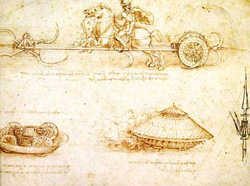|
Da Vinci’s Tank:
A War Machine for the Duke of Milan
Leonardo Da Vinci is known as the epitome of the Renaissance. Besides producing some of the world’s best-loved paintings, e.g. Mona Lisa, he was a mathematician, botanist, geologist, musician, architect and engineer. He was also a brilliant inventor, coming up with fantastical ideas that would, in time, become a reality, though not in his lifetime, and in most cases not until hundreds of years later. One such invention that eventually came to be was his armored car for warfare, otherwise known as Da Vinci’s Tank.
In the Right Place at the Right Time
 To get the full picture of what was happening in Renaissance Italy, you have to understand that the country was basically a collection of city-states that were constantly in conflict and engaging in wars with each other. When Da Vinci was looking around for a new patron, he knew that military know-how would be an important advantage. In a 1487 letter to the Duke of Milan, he stated: “I can make armored cars, safe and unassailable, which will enter the close ranks of the enemy with their artillery, and no company of soldiers is so great that it will not break through them. And behind these the infantry will be able to follow quite unharmed and without any opposition.” Duly interested and impressed, the Duke of Milan employed him.
To get the full picture of what was happening in Renaissance Italy, you have to understand that the country was basically a collection of city-states that were constantly in conflict and engaging in wars with each other. When Da Vinci was looking around for a new patron, he knew that military know-how would be an important advantage. In a 1487 letter to the Duke of Milan, he stated: “I can make armored cars, safe and unassailable, which will enter the close ranks of the enemy with their artillery, and no company of soldiers is so great that it will not break through them. And behind these the infantry will be able to follow quite unharmed and without any opposition.” Duly interested and impressed, the Duke of Milan employed him.
Aspects of the Tank’s Design
Da Vinci’s drawings, which are dated around 1485, clearly show how his inventions stemmed from his vast knowledge of nature. In the case of Da Vinci’s tank, the vehicle’s conical cover was obviously inspired by a turtle’s shell, a suitable armor. This outer covering was to be made of wood but reinforced with some metal plates to increase thickness. Those with slanting angles (an engineering trick rediscovered during World War I) would effectively deflect enemy fire. The war machine was designed to be driven directly onto the battlefield, powered by two large inside cranks operated by four strong men.
Da Vinci’s tank was outfitted with an array of light cannons, as many as several dozen, located around the perimeter of the vehicle, allowing shots to be fired in any direction. A sighting turret at the top of the machine would allow for the coordination of cannon firings with the steering of the vehicle.
An Intentional Faulty Design?
Oddly enough, if built the way he drew it, Da Vinci’s tank would not have been able to move at all because the cranks were set in opposite directions. It is uncharacteristic of the clever man to make such an obvious error, indicating to some scholars that he either built this flaw into the design to protect it from being stolen or because he was a pacifist at heart and hated warfare. However, others can argue that Da Vinci loved animals, and would have wanted his tank to function as it would have effectively replaced the use of elephants on the battlefield.
An additional flaw existed in the wheel design. Although outfitted with studs to help with traction, they were so thin that in damp conditions with soft ground, the wheels would have most likely sunk into the mud, rendering the tank immobile.
Da Vinci’s tank is but one of his many inventions, built merely to see if it would work. Correcting the “error” in the design, the tank was constructed and functioned exactly as he had anticipated. Nevertheless, war tanks would not materialize until more than 400 years later. Prototyped by the British, the first versions of modern tanks made their appearance in 1915.
